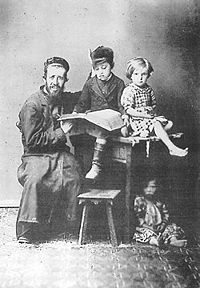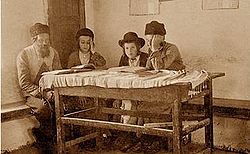- Jewish education
-
 A Jewish father teaching a child in 19th century Podolia.
A Jewish father teaching a child in 19th century Podolia.
Jewish education (Hebrew: חינוך, Chinuch) is the transmission of the tenets, principles and religious laws of Judaism. Due to its emphasis on Torah study, many have commented that Judaism is characterised by "lifelong learning" that extends to adults as much as it does to children.
Contents
History
The tradition of Jewish education goes back to biblical times. One of the basic duties of Jewish parents is to provide for the instruction of their children. The obligation to teach one's children is set forth in the first paragraph of the Shema Yisrael prayer: “Take to heart these instructions with which I charge you this day. Impress them upon your children. Recite them when you stay at home and when you are away, when you lie down and when you get up. Bind them as sign on your hand and let them serve as a symbol on your forehead; inscribe them on the doorposts of your house and your gates.” (Deut 6:6-9).[1]
Deuteronomy contains several references to the duty to provide education: “Remember the days of old, consider the years of ages past; ask your father, he will inform you, your elders, they will tell you.” (Deut 32:7). The Book of Proverbs also contains many verses related to education: “My son, do not forget my teaching, but let your mind retain my commandments; For they will bestow on you length of days, years of life and well-being.“ (Prov 3:1-2).[2]
Elementary school learning was regarded as compulsory by Simeon ben Shetah as early as 75 BCE and Joshua ben Gamla in 64 CE. The education of older boys and men in a beit midrash goes back to the Second Temple period. The importance of education is stressed in the Talmud, which states that children should begin school at six. The rabbis stated that they should not be beaten with a stick or cane, that older students should help those who were younger, and that children should not be kept from their lessons by other duties. According to Judah ben Tema, “At five years the age is reached for studying the Bible, at ten for studying the Mishnah, at thirteen for fulfilling the mitzvoth, at fifteen for studying the Talmud.” (Avot 5:21). In keeping with this tradition, Jews established their own schools or hired private tutors for their children until the end of the 18th century. Schools were housed in annexes or separate buildings close to the synagogue.[3]
Rabbi Meir Simcha of Dvinsk (in his Meshech Chochma) observes that God's statement "[Abraham is blessed because] he will instruct his children and his house after him to follow in God's ways to perform righteousness and justice" (Genesis 18:19) is an implicit mitzvah to teach Judaism.
Formal Jewish education
Primary schooling
The Talmud (tractate Bava Bathra 21a) attributes the institution of formal Jewish education to the first century sage Joshua ben Gamla. Prior to this, parents taught their children informally. Ben Gamla instituted schools in every town and made education compulsory from the age of 6 or 7. The Talmud attaches great importance to the "Tinokot shel beth Rabban" (the children [who study] at the Rabbi's house), stating that the world continues to exist for their learning and that even for the rebuilding of the Temple in Jerusalem classes are not to be interrupted (tractate Shabbat 119b).
The yeshiva
In Mishnaic and Talmudic times young men were attached to a beth din (court of Jewish law), where they sat in three rows and progressed as their fellow students were elevated to sit on the court.
After the formal court system was abolished, yeshivot became the main places for Torah study. The Talmud itself was composed largely in the yeshivot of Sura and Pumbedita in Babylonia, and the leading sages of the generation taught there. Yeshivot have remained of central importance in the Orthodox community to this day. Until the 19th century, young men generally studied under the local rabbi, who was allocated funds by the Jewish community to maintain a number of students. The Hasidic masters and the Lithuanian rabbi Chaim Volozhin both founded centralised yeshivot.
Jewish schools
 Cheder in Meron, 1912
Cheder in Meron, 1912
The phenomenon of the "Jewish day school" is of relatively common origin. Until the 19th and 20th century, boys attended the Cheder (literally "room") or Talmud Torah where they were taught by a Melamed tinokot (children's teacher).
The first Jewish day schools developed in Germany, largely in response to the higher emphasis in general on secular studies. In the past, an apprenticeship was sufficient to learn a profession, or alternatively several years in a gymnasium could prepare one adequately for university. Rabbis who pioneered Jewish day schools included rabbi Samson Raphael Hirsch, whose Realschule in Frankfurt am Main served as a model for numerous similar institutions.
Today, there are over 750 day schools in the United States and 205,000 students in those schools.[1] and hundreds of thousands of Jewish children attend religious, Hebrew and congregational schools [2].
Girls' education
It was also in the 19th and early 20th century, with the advent of public education for all, that an emphasis was first placed on girls' education. Before this, particularly in Eastern Europe, girls received their Jewish and Hebrew education at home, and were often illiterate in Hebrew. In the 19th century, public education was made compulsory in most of Europe and in order to maintain educational control over the Jewish children, Jewish schools became a reality. It was as a result of the initiative of Sarah Schenirer, that the first Jewish girls' Beis Yaakov school opened in Kraków in 1917.
Informal Jewish education
Youth Groups
Recent studies Ref estimate a population of 650,000 Jewish middle and high school students. Most of these attend Jewish youth groups or participate in activities funded by Jewish youth organizations Jewish youth organizations. Many of these are Zionist youth movements. The various organizations differ in political ideology, religious affiliation, and leadership structure, although they all tend to be characterized by a focus on youth leadership.
Summer camps
Jewish summer camps are a tool for creating ties with a particular denomination of Judaism and/or orientation to Israel. Camps are sponsored by the Orthodox, Conservative and Reform movement, by Jewish community centers, and by Zionist movements such as Young Judaea, Habonim Dror, Hashomer Hatzair and B'nei Akiva.[4] Over 70,000 campers participate in over 150 non-profit Jewish summer camps, especially in the United States. In addition, the Foundation for Jewish Camp estimates that these camps are staffed by over 8,500 Jewish college-aged counselors. Outside the United States, similar camps are generally organized by various philanthropic organizations and local Jewish youth movements. The Camp Ramah network, affiliated with Conservative Judaism runs camps in North America where youngsters experience traditional Shabbat observance, study Hebrew and observe the laws of kashrut.[5]
Student organizations
Much informal Jewish education is organized on university campuses. This is often supported by national organizations, such as Hillel (United States) or the Union of Jewish Students (United Kingdom), or by international organizations such as the World Union of Jewish Students and the European Union of Jewish Students.
Drama-based education
One of the earliest examples of drama-based Jewish education is the theatrical works of Rabbi Moshe Chaim Luzatto (Ramchal 1707-1746, b. Italy), who wrote plays with multiple characters on Jewish themes.[6] While the use of such plays was probably rare in traditional Jewish education, the Etz Chaim school of Jerusalem reportedly staged plays in the 1930s. One such play put King David's general Joab on trial for his various crimes. The students and faculty played the roles of judge, advocates and a jury, all based on extensive Biblical and Talmudic research.
In more recent times, drama is being further developed as an educational tool [3]. For example, Detroit, MI has an ensemble theater devoted to education and outreach.[4]. Programs such as Jewish Crossroads by Shlomo Horwitz provide educational theater in schools and synagogues in various English-speaking countries [5]. The Lookstein Center at Bar Ilan, a think tank geared to Jewish educators in the Diaspora, lists many drama-related programs on their website for use of teachers in the classroom [6].
Sports-based education
Sports is another vehicle to connect Jewish youth to Judaism and Israel. Bring It In - Israel offers a sports volunteering program in Israel that cultivates a cadre of young leaders who return to their communities to promote interest in Israel and Judaism.[7]
References
- ^ Jewish education
- ^ Jewish education
- ^ Jewish education
- ^ Jewish summer camps
- ^ "Camp Ramah - Beth El Synagogue Omaha, NE". Webcache. http://webcache.googleusercontent.com/search?q=cache:kOE6eZneK08J:www.bethel-omaha.org/ramah.shtml+ramah+camps+kosher+shabbat&cd=8&hl=en&ct=clnk. Retrieved September 14, 2010.
- ^ Benyehuda.org
- ^ Bring It In - Israel
- The World of the Jewish Youth Movement by Daniel Rose - on movements and informal education
External links
- AJU American Jewish University
- JESNA Jewish Education Service of North America
- CAJE The Coalition for the advancement in Jewish Education
- Lookstein The Lookstein Center for Jewish Education
- Hartman Shalom Hartman Institute, Jerusalem
- Mofet JTEC Jewish Portal of Teacher Education
- FJC Foundation for Jewish Camp
- PAIDEIA The European Institute for Jewish Studies in Sweden
Jewish education Types of organization Cheder · Yeshiva (list) · Mesivta · Seminary · Midrasha (list) · Mechina · Hebrew school · Jewish day school · Youth organizations (Zionist)
Higher education Officials Rosh yeshiva · Menahel · Melamed · Mashpia · Mashgiach Ruchani · Rosh Kollel
Related topics Categories:- Jewish education
- Jewish youth organizations
- Jewish summer camps
Wikimedia Foundation. 2010.
